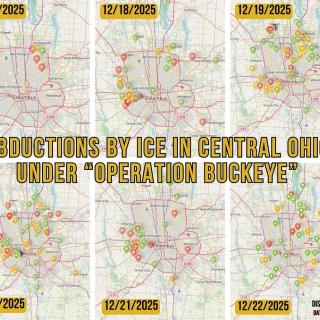According to the Ohio Secretary of State, the people of Ohio defeated a November 3 proposition to legalize marijuana by a tally of nearly 2:1.
The official vote count is not plausible.
The assertion that the election was probably stolen fits a well-established Ohio pattern of official manipulation of electronic poll books and voting machines.
Issue 3’s promoters should demand a recount, though the system is rigged and they would certainly be stonewalled. As in 2004, critical election records are likely to not materialize even though they are legally required to be maintained.
Given evidence at very least from Cincinnati, Dayton and at least three pre-election statewide polls, the margin of defeat approaches the range of virtual statistical impossibility.
The controversial measure would have established an oligarchy of ten licensed growers operating regulated indoor grow sites of up to 300,000 square feet each. The pro-marijuana activist community was divided on the measure (disclosure: Bob voted against it, Harvey voted for it).
Here are some basic facts:
· Ohio Secretary of State Jon Husted, a right-wing Republican and future gubernatorial hopeful, ran this election.
· Despite his official responsibility to evenhandedly administer a fair election, Husted took an extremely aggressive role against Proposition 3, vehemently opposing legalization of marijuana in any form. In this obvious conflict of interest he followed former Secretary of State J. Kenneth Blackwell, who in 2004 ran Ohio’s presidential election while co-chairing the state committee to re-elect George W. Bush.
· Less than a week before this year’s election, Husted accused Issue 3’s promoters of fraud, and has vowed to prosecute
· Husted vehemently supported Issue 2, designed by corporate cronies in the legislature to negate (on “anti-monopoly" grounds) Issue 3’s legalization plan even if passed by the voters. Before the November 3 vote Husted falsely stated that the state’s constitution required that Issue 2 would override Issue 3.
· Neither Husted nor the legislature proposed such anti-monopoly legislation in 2009, when they supported passage of a similar bill to establish corporate-owned casinos here.
Here are six preliminary facts that should concern voting rights activists in Ohio:
1. Three major polls prior to the election showed public support for Issue 3 in the range of 51-53% and Responsible Ohio, the coalition behind Issue 3, confirmed to the Free Press that its internal tracking polls were consistent with these numbers.
2. The official vote total of 65-35% against the marijuana measure involves a shift of more than 15% away from the tracking poll numbers, calling the official vote count into question. The same thing happened in Ohio in 2005 with the Reform Ohio Now measures related to creating a nonpartisan election administration system in the state. The vote results appeared to be flipped by up to 40 points.
3. Early on Election Day, media reported “glitches” in the electronic poll books in Cincinnati. Such breakdowns are standard operating procedure in Ohio, giving the state’s operatives time and cover to manipulate the vote count. So extensive was the meltdown of the iPad tablets used as poll books in Hamilton County, Ohio (home of Cincinnati) that the state judge ordered the polls open an hour and a half longer.
4. Voters in Hamilton County reported that when the voting roll tablets malfunctioned there was no option to look up their voting registrations on paper and they were told to come back later.
5. Screen shots taken in real-time from WHIO’s website, a Dayton TV station, show radical and inexplicable shifts in vote totals for Issues 1 and 3. One screen shot taken at 9:39pm shows Issue 3 passing with 65% of the vote. Eleven minutes later, the percentages for Issue 3 flipped. The screen shot shows Issue 3 inexplicably losing 354,796 votes in the eleven minute span.
6. Also on Election Day, Cincinnati’s News Fox 19 bizarrely issued an apology for accidentally running “mock results” during the Judge Judy program for the election on November 2, the day before Election Day. “We apologize for this mistake and want to assure you that your vote matters and we want to encourage you to head to the polls today,” the station stated on November 3.
There are enough irregularities in Ohio’s statewide November election to merit a thorough investigation of the Buckeye State’s plans for the presidential election. The state does not need a repeat of the 2004 voting debacle.
Voters who experienced or witnessed election irregularities should contact the Free Press at colsfreepress.com.






